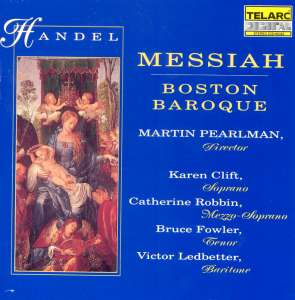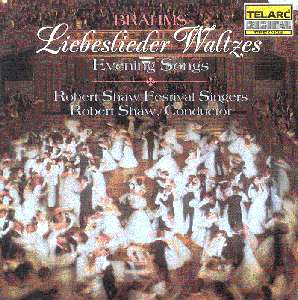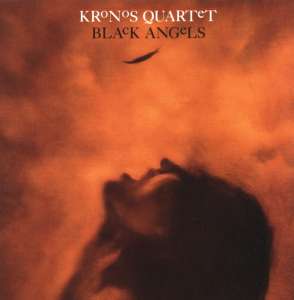Music Reviews
Classical Music - Part 17 - August, 2000Baroque, Brahms, and the Boistrous
James Foster
Fine Arts Instructor
Russellville High School
Ratings: 
Extraordinary 
Good 
Acceptable 
Mediocre 
Poor

"Handel's Messiah"
Boston Baroque, Martin Pearlman, Director, Karen Clift, Soprano
Telarc; CD-80322
Performance: 
Audio: 
The true spirit of the Mature Baroque Vocal style comes alive in this interpretation of George Friedrich Handel's "Messiah". Most Baroque vocal recordings are heavy on operatic elements with a cast of thousands; however, Pearlman, the soloists, and chorus members have done an outstanding job capturing the simplistic vocal and rhythmic qualities of this work. From the Sinfonia to the Amen chorus, dance rhythms and vocal inflections abound. This is the first recording in which these interpretive elements are combined with impeccable diction.
In 1741, Handel was invited for a series of concerts in Dublin, Ireland. This invitation came at one of the lowest points in his career. He had recently suffered a stroke, and his thriving Italian Opera Company collapsed. Charles Jennens, librettist, felt Handel should spend more time on this work (completed in three weeks), but Handel felt divine inspiration and concluded that the work was ready for performance. Messiah premiered triumphantly on April 13, 1742 and later in London (1743). Handel continued revising certain parts of the work based upon soloists and performance areas throughout his lifetime. While there are three definitive versions of this work, Autograph, Dublin, and Foundling Hospital, Pearlman selected the Dublin version due to Handel's revision from the original Autograph.
Rhythmic and textural elements are the underlying components of this era. In this recording, these elements are taken to new limits. From the beginning (Sinfonia), the listener becomes enraptured with the double dotted rhythms and the light sensitive nature of the orchestra's playing. Karen Clift's "I know that my Redeemer liveth" excels in her clarity and understanding of the text. One can't help but feel that Catherine Robbin�s �Thou that tellest good tidings of Zion� is the way that Handel envisioned the mezzo-soprano's tessitura. Most recordings include a tenor of extraordinary quality and volume; Bruce Fowler is no exception. Representing the Angel's pronouncement, Folwer's expressiveness is truly heard in "Every valley shall be exalted." Not to be circumvented, Victor Ledbetter's voice complements the vocal palette with lyricism. All oratorios are not complete without a chorus that moves the story line from one recitative/aria to the next. In this case, the chorus is amazing in its clarity and handling of the melismatic passages. There is no weak link in this performance. It is a definite must for any music listener!
- James Foster -

"Brahms Liebeslieder Waltzes, Evening Songs
Robert Shaw Festival Singers, Robert Shaw, Conductor
Telarc; CD-80326
Performance: 
Audio: 
When a classical music enthusiast thinks of Johannes Brahms, one usually thinks of his four great symphonies and his chamber works. Granted, those works stand as giants of late Romanticism, but there are some gems in his light works. The Liebeslieder Waltzes (Love Song) and his Sieben Abendlieder (Seven Evening Songs) are of this category. They are truly inspired through his longstanding association with the Schumanns (Robert and Clara).
These gems were written after Brahms moved to Vienna (1863) when his duties included conducting several amateur choral groups. The first set of Liebeslieder Waltzes were written as a piano duet (Op. 39), and their popularity soon gave rise to "Piano Duets (and voices ad libitium)" (Op. 52, 65). Georg Friedrich Daumer's Polydora provides the sentimental and often conversation-like text for the waltzes (Op. 52). An added text from Wolfgang von Goethe complements Daumer's poetry in Op. 56. As in his other chamber works, the intimacy of live performance is somewhat lost through recordings, but the gist of the composer's intentions is achieved. Concluding this recording is Seven Evening Songs that date from the last years of his life.
Robert Shaw exploits the rhythmic fluidity with perfection. It is his comprehension of late Romanticism with its emphasis on rubato playing and the intimacy of chamber music that gives the listener a special treat. The ongoing lyric conversation between male and female chorus members with an occasional soloist demonstrates Brahms' original intention for these works: amateur music making. Norman Mackenzie and John Wustman supply masterful four-hand piano playing. At times, the listener may concentrate more on the piano lines and consider the chorus as subordinate accompaniment. The audio quality is not as good as one would like, but the CD is a must for light enjoyment on a summer's evening.
- James Foster -

"Black Angels"
Kronos Quartet
Elektra Nonesuch; 9-79242-2
Performance: 
Audio: 
WARNING: This CD contains intense sounds that represent the spirit of the human soul! The Kronos Quartet is the most recognized string quartet. In Black Angels, the Grammy nominated CD, the exploration of man's struggle with their existence is displayed through prominent 20th Century composers and one 16th Century composer. This CD is not for everyone, but provides much insight to feelings, thoughts, and emotions. Excellently recorded, the listener will receive a delight in the display of string instrument playing.
Black Angels (1970) is considered the only String quartet whose inspiration is the Vietnam War. This work portrays a voyage of the soul. The three stages of this voyage are Departure (fall from grace), Absence (spiritual annihilation), and Return (redemption). One cannot but feel the helplessness portrayed through electronic amplification and non-traditional use of the stringed instruments. Screams, shouts, sirens, and utter loneliness of the Vietnam War are heard. Only through repetitive listening can one fully grasp this work.
Spem in Alium (Sing and Glorify, late 16th Century) jumps back to the time of Imperial England. Thomas Tallis, famed court composer of Henry VIIII, Edward VI, Mary Tudor, and Elizabeth I, presents a somber, but inspiring motet whose redemptive powers are found through redemption by God. "Doom. A Sigh" (1989) is based on two songs, sung by Mrs. Pieter Benedek and Mrs. George Imre, which recounts a bloody battle in a Romanian community. Istvan Marta recorded people singing their native songs. Government oppressiveness punished those very people through heavy fines and imprisonment. "They are There! Fighting for the People's New Free World" is a Charles Ives work that recounts World War I and was revised again after World War II. Dmitri Shostakovich's Quartet No. 8 (1960) recounts the tribulations and strife of Russian and is dedicated "to the victims of fascism and war." Expertly played, the Allegretto movement provides some sense of hope in this dark work.
Kronos Quartet's Black Angels is not for everyone and will not be appreciated in one sitting. This masterful recording allows the listener true delight in its capturing the performers precise string intruments� articulations.
- James Foster -� Copyright 2000 Secrets of Home Theater & High Fidelity
Return to Table of Contents for this Issue.

